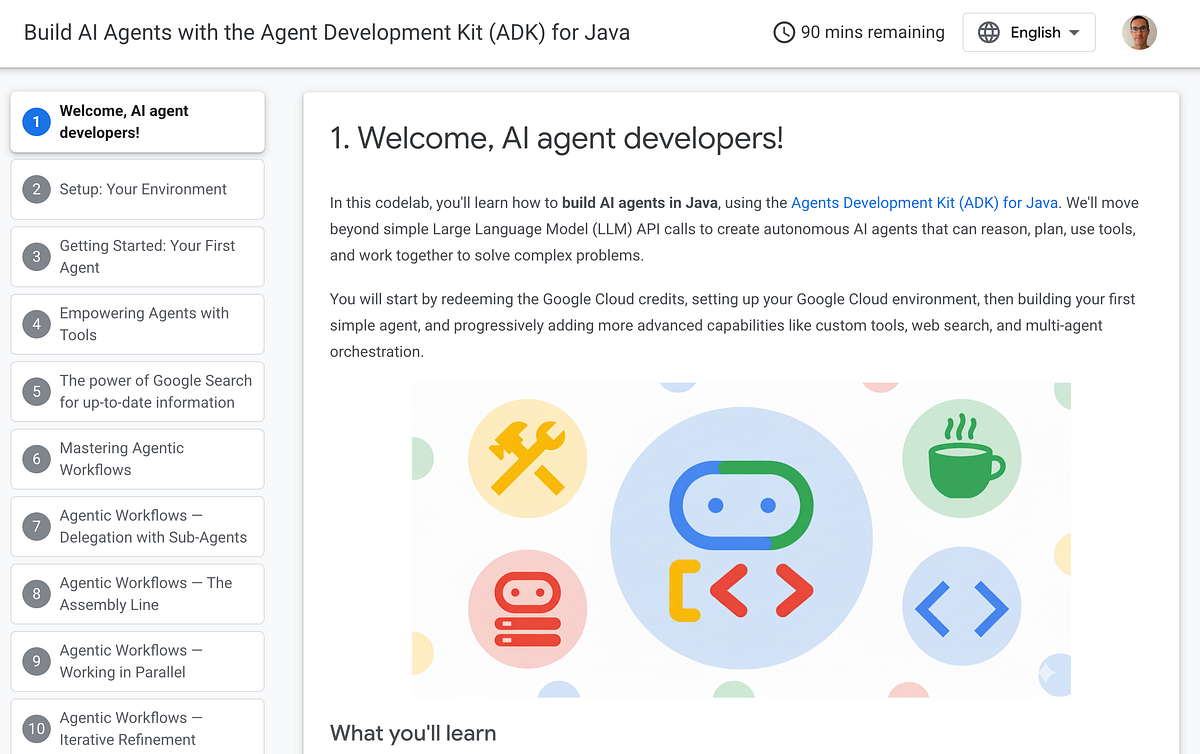
Build a Kitchen Renovation System using Vertex AI ADK!
When your application has multiple agents working together autonomously and together as required to cater to its larger purpose with each of its agents being independently knowledgeable and responsible for a specific focus area, then your application becomes a multi-agent system. Agents are autonomous programs that can make decisions generatively and based on instructions and information made available to them and are responsible for the specific area of focus for which they are created.
Agent Development Kit (ADK) is a flexible and modular framework for developing and deploying AI agents. ADK supports building sophisticated applications by composing multiple, distinct agent instances into a Multi-Agent System (MAS).
In ADK, a multi-agent system is an application where different agents, often forming a hierarchy, collaborate or coordinate to achieve a larger goal. Structuring your application this way offers significant advantages, including enhanced modularity, specialization, reusability, maintainability, and the ability to define structured control flows using dedicated workflow agents.
- First, It’s important to have a proper understanding and reasoning of the specialization for each agent. — “do you know why you need a specific sub-agent for something”, work that out first.
- Second, How to bring them together with a root agent to route and make sense of each of the responses.
- Third, There are multiple types of agent routing that you can find here in this documentation. Make sure which one suits your application’s flow. Also what are the various contexts and states that you need for your multi-agent system’s flow control.
Let’s build a multi-agent system to handle kitchen renovations. That’s what we’ll do. We’ll build a system with 3 agents.
- Renovation Proposal Agent
- Permits and Compliance Check Agent
- Order Status Check Agent
Renovation Proposal Agent, to generate the kitchen renovation proposal document. Permits and Compliance Agent, to take care of permits and compliance and Order Status Check Agent, to check order status. We have a root agent that orchestrates these agents based on the requirement.
Let’s get started with getting the multi-agent system implemented.
Setup GCP Project
- Login to Google Cloud console.
- Make sure you have an active project with an active billing account. Create a new project if you don’t already have one.
- Also if you are reading this and would like to get hold of some credits to help you get started with Google Cloud and to use ADK, use this link to redeem credits. You can follow the instructions here to redeem it. Please note that this link is valid only till the end of May for redemption.
- Activate Cloud Shell by clicking this link. You can toggle between Cloud Shell Terminal (for running cloud commands) and Editor (for building projects) by clicking on the corresponding button from Cloud Shell.
- Make sure to have Python 3.9+
Set up Environment & Install ADK
- Create & Activate Virtual Environment (Recommended)
- From your Cloud Shell Terminal, create a Virtual Environment:
python -m venv .venv
3. Activate the Virtual Environment:
source .venv/bin/activate
4. Install ADK:
pip install google-adk
5. From Cloud Shell Terminal, create a directory in your desired project location:
mkdir renovation-agent
Create the multi-agent system
- Go to Cloud Shell editor and create the following project structure by creating the files (empty to begin with):
renovation-agent/
__init__.py
agent.py
.env
2. Go to __init__.py and update with the following content:
from . import agent
3. Go to agent.py and update the file with content from the following location:
...
'''
# Root Agent Definition
'''
root_agent = Agent(
model=MODEL_NAME,
name=ROOT_AGENT_NAME,
description=("Agent that manages and executes the building renovation proposal for a home owner."),# Instructions for intent detection: Combine guardrails string
# and the sub-agent routing instruction
instruction=(
f""" {root_agent_system_instruction}
**********************************************************************************************************
**********************************************************************************************************
- If the user asks you to create a proposal document
invoke the proposal_agent
- If the user wants to create a checklist of permits or
compliance documentation, invoke the permits_agent.
- If the user wants to execute ordering of materials,
place order or get the status of delivery,
invoke the ordering_agent without asking more questions.
**********************************************************************************************************
**********************************************************************************************************
"""),
generate_content_config=types.GenerateContentConfig(temperature=0.2),
# Orchestrating sub agents
sub_agents=[
proposal_agent,
permits_agent,
ordering_agent
],
)
...
Comment out the sub agent “ordering_agent” if you do not want to create a Cloud Run Function for getting order status from AlloyDB.
If you want to try the Ordering Agent, steps are as follows
Create AlloyDB cluster and instance, table and data
- To create a cluster and instance, follow the step mentioned in STEP 4.
Database Setup: https://codelabs.developers.google.com/smart-stylist-app#3
2. To create table and insert data, run the sql statements from here: https://github.com/AbiramiSukumaran/adk-renovation-agent/blob/main/database_script.sql
Create a Cloud Run Function in Java to extract order status information
- Create Cloud Run Function from here: https://console.cloud.google.com/run/create?deploymentType=function
- Set the name of the function to “check-order-status” and choose the “Java 17” as runtime.
- You can set authentication to “Allow unauthenticated invocations” since it is a demo application.
- Follow steps in the link below to make sure your Cloud Run Function can talk to your AlloyDB data and retrieve:
- Go to “Create the Cloud Run Function” section in step 9 of the codelab https://codelabs.developers.google.com/smart-stylist-app#9 link.
- Follow all instructions from points 4 to 15 in that section.
- Click “Create”.
Once the function is created and placeholder code loaded
1. Change the name of the Java file to “ProposalOrdersTool.java” and the class name to “ProposalOrdersTool”.
2. Replace the placeholder code in ProposalOrdersTool.java & pom.xml with code from the respective files in the folder “Cloud Run Function” in this repo.
3. In line 73 of ProposalOrdersTool.java that contains the following code, replace the placeholder values with values from your configuration:
String ALLOYDB_INSTANCE_NAME = "projects/<>/locations/us-central1/clusters/<>/instances/<>";
4. Deploy the function and test it.
Set up .env variables
Set up your values for the parameters in the template .env file in this repo.
Make sure you have the Cloud Storage Bucket
This is to store the proposal document that the agent generates. Create it and provide access so the multi-agent system created with Vertex AI can access it. Here is how you can do it:
https://cloud.google.com/storage/docs/creating-buckets#console
You can run the following to test it in the terminal:
adk run .
You can run the following to test it in an ADK provisioned UI:
adk web
The agent.py file defines the structure and behavior of our kitchen renovation multi-agent system using the Agent Development Kit (ADK). Let’s break down the key components:
Agent Definitions
RenovationProposalAgent
This agent is responsible for creating the kitchen renovation proposal document. It optionally takes input parameters like kitchen size, desired style, budget, and customer preferences. Based on this information, it uses a Large Language Model (LLM) Gemini 2.5 to generate a detailed proposal. The generated proposal is then stored in a Google Cloud Storage bucket.
PermitsAndComplianceCheckAgent
This agent focuses on ensuring the renovation project adheres to local building codes and regulations. It receives information about the proposed renovation (e.g., structural changes, electrical work, plumbing modifications) and uses the LLM to check permit requirements and compliance rules. The agent uses information from a knowledge base (which you can customize to access external APIs to gather relevant regulations).
OrderingAgent (Optional)
This agent, (you can comment it out if you don’t want to implement now), handles checking the order status of materials and equipment needed for the renovation. To enable it, you’ll need to create a Cloud Run function as described in the setup steps. The agent will then call this Cloud Run function, which interacts with an AlloyDB database containing order information. This demonstrates integration with a database system to track real-time data.
Root Agent (Orchestrator)
The root_agent acts as the central orchestrator of the multi-agent system. It receives the initial renovation request and determines which sub-agents to invoke based on the request’s needs. For example, if the request requires checking permit requirements, it will call the PermitsAndComplianceCheckAgent. If the user wants to check order status, it will call the OrderingAgent (if enabled).
The root_agent then collects the responses from the sub-agents and combines them to provide a comprehensive response to the user. This could involve summarizing the proposal, listing required permits, and providing order status updates.
Data Flow
The user initiates a request through the ADK interface (either the terminal or the web UI).
- The request is received by the root_agent.
- The root_agent analyzes the request and routes it to the appropriate sub-agents.
- The sub-agents use LLMs, knowledge bases, APIs, and databases to process the request and generate responses.
- The sub-agents return their responses to the root_agent.
- The root_agent combines the responses and provides a final output to the user.
Other Key Concepts
LLMs (Large Language Models)
The agents rely heavily on LLMs to generate text, answer questions, and perform reasoning tasks. The LLMs are the “brains” behind the agents’ ability to understand and respond to user requests. We are using Gemini 2.5 in this application.
Google Cloud Storage
Used to store the generated renovation proposal documents. You need to create a bucket and grant the necessary permissions for the agents to access it.
Cloud Run (Optional)
The OrderingAgent uses a Cloud Run function to interface with AlloyDB. Cloud Run provides a serverless environment to execute code in response to HTTP requests.
AlloyDB (Optional)
If you’re using the OrderingAgent, you’ll need to set up an AlloyDB database to store order information.
.env file
The .env file stores sensitive information like API keys, database credentials, and bucket names. It’s crucial to keep this file secure and not commit it to your repository. It also stores configuration settings for the agents and your Google Cloud project. The root_agent or supporting functions will typically read values from this file. Make sure all required variables are properly set in the .env file. This includes the Cloud Storage bucket name
The multi-agent system is designed to streamline the kitchen renovation process by automating tasks such as proposal generation, permit checking, and order status tracking. Each agent has a specific role, and the root_agent coordinates their activities to provide a comprehensive solution. The system leverages LLMs, Google Cloud services, and potentially external APIs to deliver its functionality. Here is a link to the product documentation.
Let me know what you are building!!!
Source Credit: https://medium.com/google-cloud/multi-agent-application-with-agent-development-kit-50a942915459?source=rss—-e52cf94d98af—4




